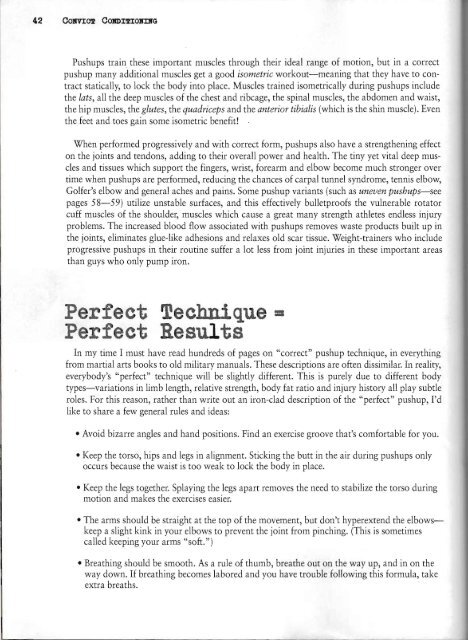Convict Conditioning - Paul Wade
Create successful ePaper yourself
Turn your PDF publications into a flip-book with our unique Google optimized e-Paper software.
42 OOlNIC!1! OOBDJ;!1!J;OBmG<br />
Pushups train these important muscles through their ideal range of motion, but in a correct<br />
pushup many additional muscles get a good isometric workout-meaning that they have to contract<br />
statically, to lock the body into place. Muscles trained isometrically during pushups include<br />
the lats, all the deep muscles of the chest and ribcage, the spinal muscles, the abdomen and waist,<br />
the hip muscles, the glutes, the quadriceps and the anterior tibialis (which is the shin muscle). Even<br />
the feet and toes gain some isometric benefit!<br />
When performed progressively and with correct form, pushups also have a strengthening effect<br />
on the joints and tendons, adding to their overall power and health. The tiny yet vital deep muscles<br />
and tissues which support the fingers, wrist, forearm and elbow become much stronger over<br />
time when pushups are performed, reducing the chances of carpal tunnel syndrome, tennis elbow,<br />
Golfer's elbow and general aches and pains. Some pushup variants (such as uneven pushups-see<br />
pages 58-59) utilize unstable surfaces, and this effectively bulletproofs the vulnerable rotator<br />
cuff muscles of the shoulder, muscles which cause a great many strength athletes endless injury<br />
problems. The increased blood flow associated with pushups removes waste products built up in<br />
the joints, eliminates glue-like adhesions and relaxes old scar tissue. Weight-trainers who include<br />
progressive pushups in their routine suffer a lot less from joint injuries in these important areas<br />
than guys who only pump iron.<br />
Perfect Technique =<br />
Perfect Results<br />
In my time I must have read hundreds of pages on "correct" pushup technique, in everything<br />
from martial arts books to old military manuals. These descriptions are often dissimilar. In reality,<br />
everybody's "perfect" technique will be slightly different. This is purely due to different body<br />
types-variations in limb length, relative strength, body fat ratio and injury history all play subtle<br />
roles. For this reason, rather than write out an iron-clad description of the "perfect" pushup, I'd<br />
like to share a few general rules and ideas:<br />
• Avoid bizarre angles and hand positions. Find an exercise groove that's comfortable for you.<br />
• Keep the torso, hips and legs in alignment. Sticking the butt in the air during pushups only<br />
occurs because the waist is too weak to lock the body in place.<br />
• Keep the legs together. Splaying the legs apart removes the need to stabilize the torso during<br />
motion and makes the exercises easier.<br />
• The arms should be straight at the top of the movement, but don't hyperextend the elbowskeep<br />
a slight kink in your elbows to prevent the joint from pinching. (This is sometimes<br />
called keeping your arms"soft.")<br />
• Breathing should be smooth. As a rule of thumb, breathe out on the way up, and in on the<br />
way down. If breathing becomes labored and you have trouble following this formula, take<br />
extra breaths.


